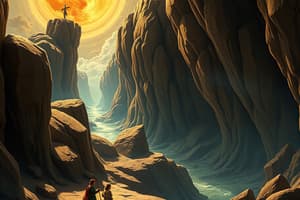Podcast
Questions and Answers
What was a significant skill that Leonardo da Vinci developed during his training in Florence?
What was a significant skill that Leonardo da Vinci developed during his training in Florence?
- Metal working
- Pottery making
- Textile design
- Sculpting (correct)
Which artwork is known for its use of atmospheric sfumato technique?
Which artwork is known for its use of atmospheric sfumato technique?
- Vitruvian Man
- Mona Lisa (correct)
- Studies of Anatomy
- The Last Supper
What did Leonardo da Vinci illustrate in his famous drawing, Vitruvian Man?
What did Leonardo da Vinci illustrate in his famous drawing, Vitruvian Man?
- The human heartbeat
- Human proportion (correct)
- The anatomy of the brain
- The solar system
In terms of his artistic techniques, which of the following did Leonardo da Vinci NOT use?
In terms of his artistic techniques, which of the following did Leonardo da Vinci NOT use?
Which of the following areas did Leonardo da Vinci NOT study?
Which of the following areas did Leonardo da Vinci NOT study?
What characterizes Leonardo da Vinci as a 'Renaissance Man'?
What characterizes Leonardo da Vinci as a 'Renaissance Man'?
What was one of Leonardo da Vinci's notable contributions to the understanding of the human body?
What was one of Leonardo da Vinci's notable contributions to the understanding of the human body?
Which of these inventions is Leonardo da Vinci credited with designing?
Which of these inventions is Leonardo da Vinci credited with designing?
Flashcards
Leonardo da Vinci's early training
Leonardo da Vinci's early training
Leonardo da Vinci received artistic training in Florence, learning painting, sculpting, and drawing from Andrea del Verrocchio.
Leonardo da Vinci's artistic mastery
Leonardo da Vinci's artistic mastery
Leonardo da Vinci excelled in art techniques like perspective, anatomy, and light, creating masterpieces like Mona Lisa and The Last Supper.
Leonardo da Vinci's scientific curiosity
Leonardo da Vinci's scientific curiosity
Leonardo displayed a deep interest in the natural world, particularly human anatomy, making detailed observations and studies.
Leonardo da Vinci's engineering
Leonardo da Vinci's engineering
Signup and view all the flashcards
Mona Lisa's technique
Mona Lisa's technique
Signup and view all the flashcards
Leonardo da Vinci's detailed approach
Leonardo da Vinci's detailed approach
Signup and view all the flashcards
"Renaissance Man"
"Renaissance Man"
Signup and view all the flashcards
Leonardo da Vinci's impact
Leonardo da Vinci's impact
Signup and view all the flashcards
Study Notes
Early Life and Training
- Born in Vinci, Italy, in 1452.
- Received early education in the Tuscan countryside.
- Trained as an artist in the workshop of Andrea del Verrocchio in Florence, gaining skills in painting, sculpting, and drawing.
- Demonstrated exceptional talents in various artistic mediums.
Artistic Career
- Mastered various techniques in art, including perspective, anatomy, and light.
- Created iconic works such as the Mona Lisa and The Last Supper, showcasing his mastery of detail and human emotion.
- Prolific painter, known for innovative technical approaches and rich imagery in his works.
- Also a sculptor, architect, musician, scientist, inventor, and more.
Scientific and Engineering Interests
- Demonstrated an insatiable curiosity about the natural world.
- Detailed studies and observations of human anatomy, capturing details with meticulous accuracy.
- Made significant contributions to understanding of human body.
- Created numerous sketches and designs of machines, including flying machines, war machines, and hydraulic pumps.
- Showcased creativity and knowledge in engineering, far ahead of his time.
- Studied optics, botany, geology, and astronomy.
Noteworthy Works
- Mona Lisa: A portrait known for its enigmatic smile and atmospheric sfumato technique.
- The Last Supper: A mural depicting the final meal of Jesus with his disciples.
- Vitruvian Man: A famous drawing illustrating Leonardo's study of human proportions.
- Studies of Anatomy: Numerous detailed sketches and drawings of the human body.
Impact and Legacy
- Considered a quintessential "Renaissance Man", excelling in multiple disciplines.
- Had a profound impact on art and science, leaving behind innovative ideas.
- Influenced generations of artists and scientists.
- His notebooks remain valuable sources of information about his thought processes and ideas.
- Continued to influence the modern day; his inventions are frequently studied and analyzed by historians.
- Continued to be admired and studied for his artistry & ingenuity.
Working Style and Techniques
- Used meticulous observation and experimentation in his work.
- Employed innovative techniques in his art, like sfumato, which blurred outlines to create subtle gradations of light and shadow.
- Paid close attention to detail in his work, meticulously documenting his observations.
- Developed a unique style, blending scientific and artistic approaches.
- Demonstrated skills in creating intricate and realistic depictions of things from life—such as the human body.
- Created detailed drawings and sketches of both his artistic and scientific work.
Personal Life and Relationships
- Details of personal relationships were scarce, but there are documented anecdotes and evidence of his contacts.
- Evidence of connections with other artists, intellectuals, and patrons during his lifetime.
Death and Final Years
- Died in Amboise, France, in 1519.
- Spent his later years in France under the patronage of King Francis I.
- Legacy endures through his vast body of work that continues to be admired and studied in the present day.
Studying That Suits You
Use AI to generate personalized quizzes and flashcards to suit your learning preferences.




